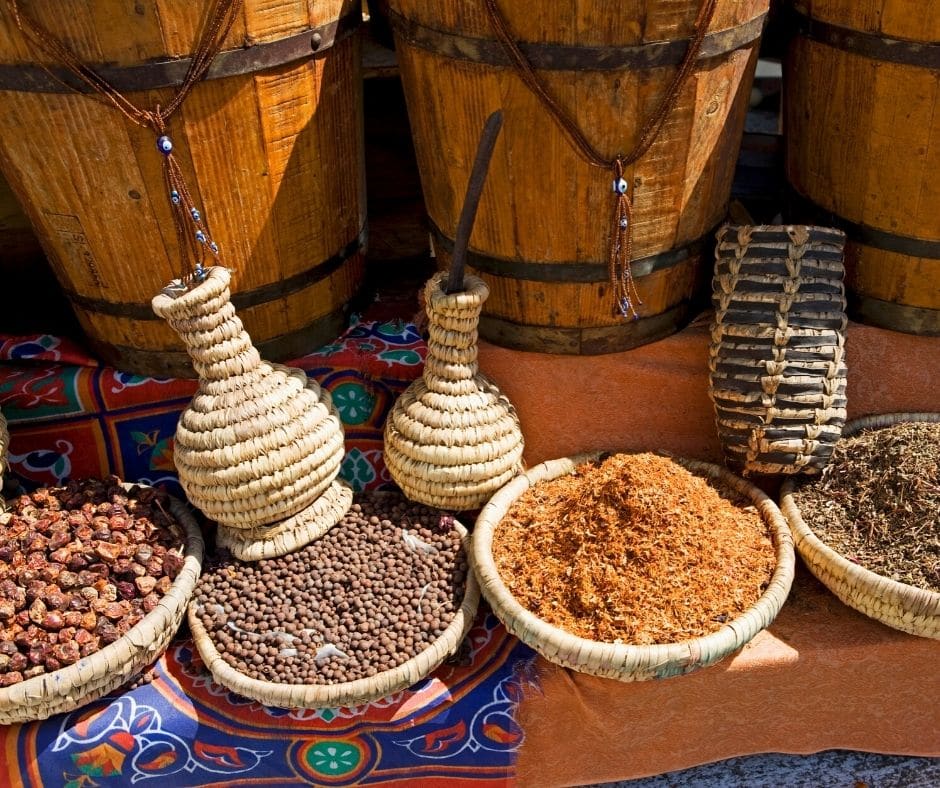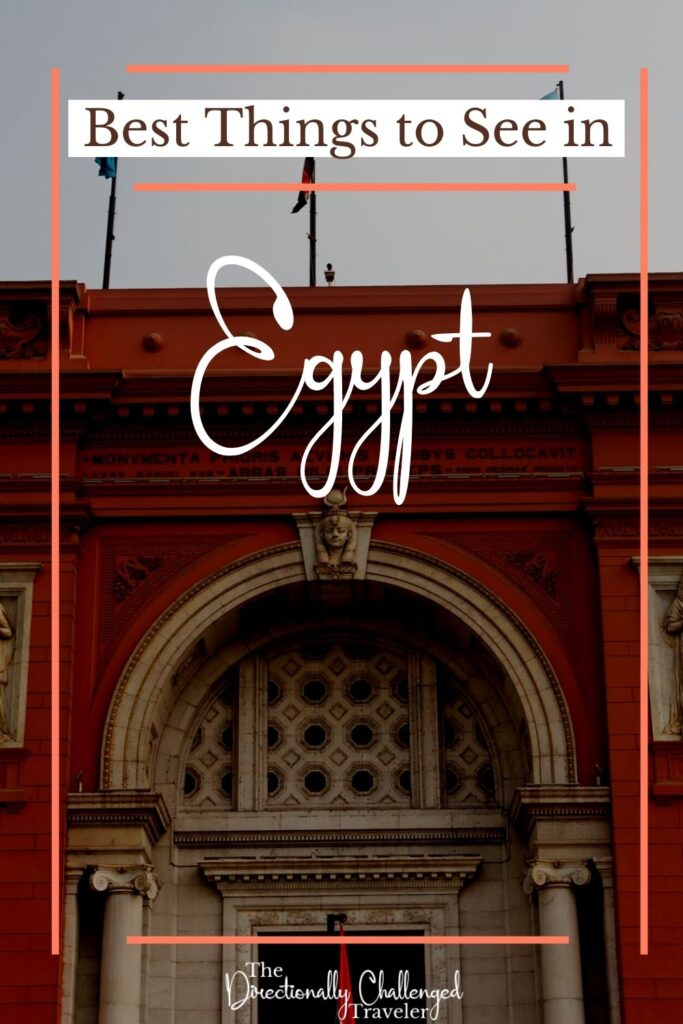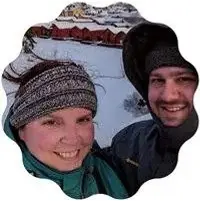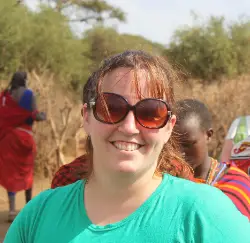The Pyramids of Giza, the last ancient wonders of the world, is a highlight for any traveler visiting Egypt. I have to admit, even my breath was taken away when I saw them. The size and grandeur of the pyramids and the engineering that took place to build them is nothing less than extraordinary. However, there is so much more to see in Egypt than just the pyramids. There are some incredible temples in Egypt that shouldn’t be missed too!
For tips to see the pyramids, visit World to Wander’s post.
If you like this post, be sure to sign up for my e-mail list for travel inspiration (and get your FREE budget printable), or connect with me on Facebook, Instagram, Twitter, or Pinterest.

“Fun” Fact: Never climb on the pyramids – even if some of the blocks are on the ground – the guards will point their very intimidating guns at you and yell at you. (My group was young and naive and followed other tourists.) Learn from our mistakes.
This post contains affiliate links. This means if you purchase something from a link, I may make a small commission at no cost to you.

The Egyptian Museum
Depending on when you are traveling to Egypt, you may have a choice of museums to visit. The Grand Egyptian Museum, a new museum being built in expected to open early 2020. It will be a whopping 5.2 million-square-foot structure, turning it into the largest museum devoted to one civilization. However, if you’re heading there before it opens, don’t fret, you still have the Egyptian Museum. My historical knowledge of Egypt is limited to what I learned from The Mummy as a kid. Awesome hieroglyphics, powerful pharaohs, beautiful queens, and of course mummies and magic! When visiting the Museum, I learned so much more about the culture and people of Egypt, which only made me appreciate the rest of the trip so much more. The impressive museum houses over 120,000 items dating back almost 5,000 years!
Not-so-fun-fact: Egyptians have been trying to get their historical artifacts from around the world for many years. Often, in other cities, you may see an Egyptian obelisk. Despite what the tour guides may tell you, the majority (probably about 95%) were stolen from Egypt. Egypt was taken over and invaded many times throughout the course of history and many of the temples were found by European explorers who thought the treasurers were theirs to take.

Luxor Temple and Karnak Temple
One of my favorite temples in all of Egypt is the Luxor Temple. The city of Luxor is home to many temples that it’s often called the “museum city” since there is so much to see and do. You’ll see ancient buildings and obelisks all over the city. If you’re driving around, usually your driver is happy to point some of them out. However, the two must-see temples in this city are the Luxor and Karnak Temples.

Fun Fact: Luxor’s name was once Thebes, the capital of Upper Egypt. Thebes was the religious capital of Egypt for thousands of years and still has maintained spiritual significance.
The Luxor Temple was built between 1392 and 1335 B.C. by Amenhotep and finished by Tutankhamun. Raneses II added to it during his reign as well. It was excavated in the 1800s. It was dedicated to the rejuvenation of kingship and was most likely where many of the pharaohs were crowned. During the Roman period, a chapel inside the Luxor Temple originally dedicated to goddess Mut was transformed into a church.
Travel Tip: To avoid the crowds, visit the Luxor temple early in the morning. However, be sure to drive by it at night at least since it is lit up.
There used to be an avenue of sphinxes running the 3km between the Luxor and Karnak temples. You can still see some of the sphinxes around the area.

The Karnak temple complex was built over 1,000 years between the Twelfth and Twentieth Dynasties. Dozens of pharaohs added their own construction to the temple complex, making it a unique historical destination in Egypt. The largest religious building ever built is the Temple of Amun-Ra within the complex. It is considered to be where the god Amun-Ra lived with his wife and son (both have their own temples on-site as well). Since there is such a long history of construction, the gods worshipped here vary greatly – which gives us a unique and impressive presentation of Ancient Egypt’s religious practices and beliefs.
The complex was in ruins when they were encountered by Napoleon’s scholars and archaeologists at the beginning of the 19th century.
Mummy Fun Fact: Karnak temple was shown to Alex O’Connell (son of Rick & Evelyn) in The Mummy Returns after putting on the Bracelet of Anubis.
Valley of the Kings & Valley of the Queens
On the west side of the Nile, near Luxor, is the Valley of the Kings. This was the burial site of almost all the kings in the 18th, 19th, and 20th dynasties – ranging over 500 years! The tombs are concealed in a lonely valley in the western hills behind Dayr al-Bahri. The tombs are sunk into mountains to hopefully protect the kings’ rich burials. The walls of the tombs are covered in sculptured and painted scenes, usually with the gods of the underworld to help the king navigate the afterlife.


While most of the tombs were raided of antiquities, both in ancient times and more recently, the little tomb of Tutankhamun was protected by a pile of rock chippings and escaped pillage. When the tomb was exhumed in 1922, the treasures (now in the Egyptian Museum in Cairo) give us a vivid glance into the burial process.

Nearby is the Valley of the Queens which was built in a similar style. It’s the burial site of the queens and some royal children of the 19th and 20th dynasties and has over 90 known tombs. The most notable tomb is Queen Nefertari, the favorite queen of Ramses II.
Abu Simbel
The Abu Simbel temples are often overlooked by travelers for the more popular Pyramids, but this is a definite must-see temple. The temples are located in southern Egypt, near Sudan, and were built as a monument to king Pharaoh Ramesses II and his queen Nefertari. The immense size of the temples is jaw-dropping enough – the four Ramesses II statues (outside the larger temple) stand at over 65 feet (20meters) tall. If you have the time, then a visit to Abu Simbel is definitely worth it.

This temple depicts Ramesses II across his lifespan and the victories he won during his reign. The smaller temple has six colossi in the front – four of which are Ramesses II, two of which are Queen Nefertari. This is a unique ode to the queen since typically women are represented on a much smaller scale than the pharaoh. When the Aswan High Dam was being developed, it was decided that in order to preserve Abu Simbel, it would be moved. The temples were taken apart brick by brick and put back together nearly perfectly. If it wasn’t moved in 1968, then the entire temple would be submerged under Lake Nasser.

Nubian Village
When people think of Egypt they think of varying shades of tan – from the sand to the dirt, to the temples. Maybe they add in the glistening blue of the Nile river. However, one place that you can always find vibrant, colorful buildings and decorations is in a Nubian village. The only way to get to a village is through a tour on a boat. Upon arrival in the village, you’ll learn about the locals’ way of living – including a tour of a home.

Usually, they offer tea and snacks, sometimes a full meal. Please know that many of the families keep young crocodiles as pets. It is a relatively common practice to have family crocodiles and once the crocodile is about the length of your arm, they are set free. If you see any that are bigger than that and kept in cages, that means they are doing it to attract tourists. If you’re brave enough while visiting, you can also take a dip in the Nile!
Egypt is a country rich with history and character that goes beyond the magnificence of the pyramids. While the pyramids are a must-see, be sure to venture down the Nile and explore more of this wonderful country!
Save this post for later!



What would you like to see in Egypt?
About the Author


One response to “5 Things to See in Egypt OTHER than the Pyramids”

This article is a fantastic resource for travelers seeking to explore Egypt beyond the iconic pyramids. The detailed descriptions of alternative attractions, such as the Egyptian Museum and various temples, provide valuable insights into the country’s rich history and culture. The personal anecdotes and practical tips make it both informative and engaging. A must-read for anyone planning a trip to Egypt!









Leave a Reply